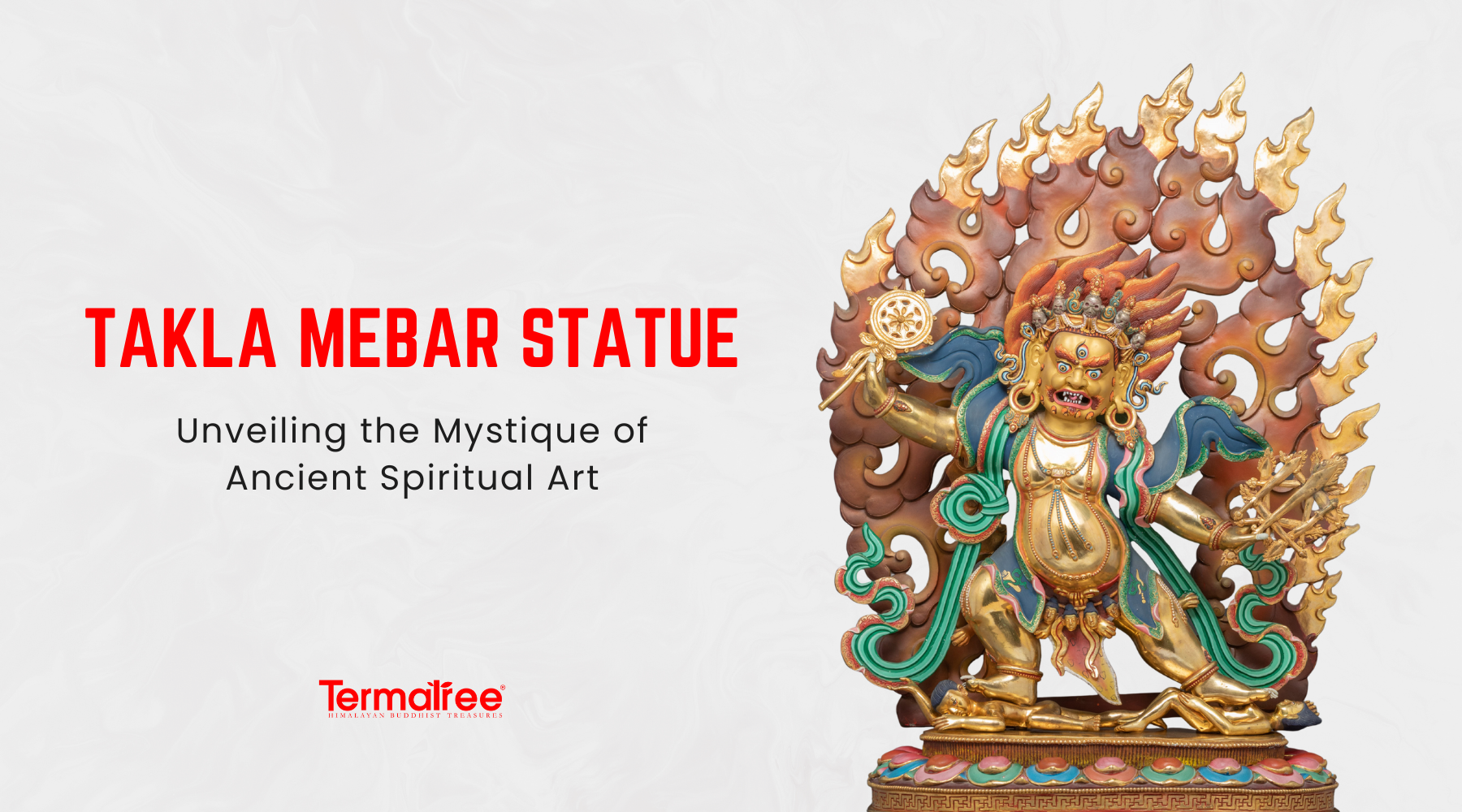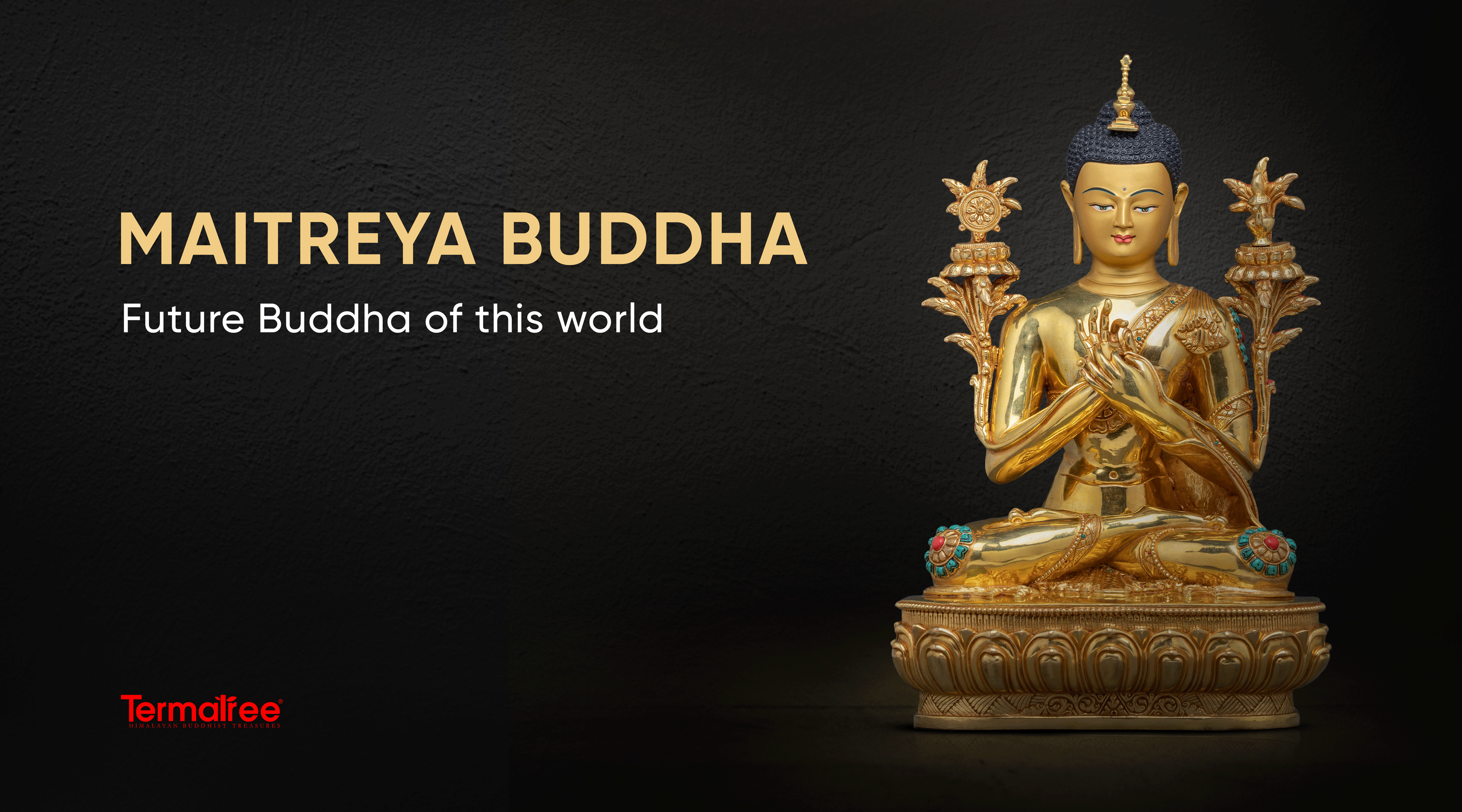Facing Fear, Embracing Wisdom: Lessons from the Blazing Protector
The Takla Mebar statue is among the prominent symbols in Tibetan Buddhism. It is an icon that makes a mysterious, reverential, and masterful impression. It is not merely a carved form, but it carries the burden of centuries of piety and has stratifications of spiritual content which speak to security, transformation, and triumph of wisdom over non-positivity. To the Tibetan practitioners, it is a sacred presence that should be respected and provides them with power. It is an eye-opener er, to the history and art enthusiasts, as it is a rare glimpse into the good workmanship and culture of the Tibetan people. The statue is unique in that it relates faith and art. Not only does it reveal the profound spiritual perspective of Buddhism, but it also reflects the artisanship, imagination and symbolism which are the elements of ancient Tibetan art. The Takla Mebar statue is a work of art, a cultural treasure, and a devotional object that will not be out of fashion. It makes us reflect on values, narratives, and traditions that it signifies. It protects the past and inspires us in the present, showing us how symbols can have power that lasts through generations.
Who Is the Takla Mebar Statue?

Takla Mebar is a powerful guardian and wrathful deity revered in Tibetan Buddhism; he embodies enlightened energy as a protector of the Dharma. His fierce appearance holds meaning because, in the context of teachings, it symbolizes the burning away of ignorance or obstruction. His form itself carries a message of meaning, as he will often be depicted with a halo of vigilance, and he is usually portrayed to guide practitioners with a demonstrative example on the spiritual journey.
Oftentimes depicted with weapons, Takla Mebar's wrathful form embodies fierce compassion, which engages with negativity while cutting through fear and illusion. He displays it all, empowering the practitioner to engage with their own inner demons and transform the energy of destruction into the wisdom of experience. Within the Tibetan tradition, wrathful deities like him emphasize that the path to enlightenment involves engaging with courage and overcoming difficulties on the Buddhist path, embodying the wisdom of strength, security, and fearlessness.
Iconography of Takla Mebar
1. Fiery hair and Flames around

The fires surrounding Takla Mebar are not just a decorative symbol; they represent an influential figure of cleansing and renewal.. They eliminate ignorance, fear, and attachments that block spiritual development, which is the capacity of the deity to transform constructive energy into wisdom. His passionate, unquenchable energy in defending the Dharma and leading typists is also depicted in the fiery aura.
2. Piercing Eyes
The eyes of Takla Mebar are broad, piercing, and alert, and the vigilance and acute observation are undiminished. They remind the practitioner to be on the spiritual road with his mind, eye, and consciousness. The eyes are also associated with insight, which enables one to see beyond illusions and grasp the tactile reality of things.
3. Fierce Expression

His expression is horrifying, and this anger is compassionate. It reveals how the deity is insistent on eliminating all obstacles and protecting those who practice to overcome their inner struggle. The anger is not directed at anyone; rather, it serves as a gauge to develop courage and endurance in overcoming the challenges.
4. Sword
Nine swords are in his left hand, which means that he approaches with brutal defense and can cut through the illusion and barriers. Along with the wheel, they declare wisdom in movement and power to protect it. The sword is a symbol of judgment and judgmental power of wisdom.
5. Dharmachakra

Takla Mebar is holding a dharmachakra, or the wheel of Dharma, in his right hand. It demonstrates the living power of the lessons of Buddha, who constantly turned to lead beings to the truth and awakening.
6. Ornaments and Jewelry
Takof Mebar has a spiritual nature and learning, which are symbolized by wings, a necklace, and a crown. This symbolism refers to profound significance, numerous spiritual accomplishments, and the benefits of a rigorous practice and obedience.
7. Posture and Implements
The pose of Takla Mebar indicates that he is prepared and decisive, either sitting still in his meditation or in one of his dynamic postures. Other instruments of the ritual, like vajras or tridents, reinforce his position as a defender, and the combination of power and compassion demonstrates that powerful energy may be directed to a positive purpose.
The Tale of Takla Mebar: Bandit to Protector
This tale recounts a dreadful Khampa bandit, Taklha, whose strength and fierce cruelty were felt in the hearts of all the distant valleys of Ngari. Takla left a violent legacy of raids and terror until the local king captured and executed him for his destructive actions. But in Tibetan belief, death is not the end. After he died, the being of Taklha did not disappear but transformed. That fierce and spirited energy became a tsen, or wrathful spirit of extreme energy, too powerful to have just dissolved into the other side. Instead of being left as a wandering, threatening spirit, in the spirit of the earth and sky, this raw energy was ritualized and repurposed, forming a new protector known as Takla Mebar, the blazing protector. No longer a bandit on the lookout to take advantage of the weak, he was born to be a protector of the Dharma, and the flames of Takla Mebar went from consuming to protecting practitioners and maintaining the teachings of the Dharma. The underlying story reflects a more profound spiritual belief, that even the most negative and destructive forces—whether in the world or in our own hearts—can be rendered protectors and allies in the movement toward awakening.
The Mantra of Takla Mebar

(Photo From Gyalshen Institute)
In relation to Tibetan Buddhism and Bön, mantras are valuable tools to call through deities for protection or a transformation of energy. This includes the mantra of Takla Mebar. It is believed that reciting this mantra will assist in removing obstacles, purifying negativity, and cultivating courage and wisdom along the spiritual path.
A very commonly recited version of the mantra is:
"OM MA WA MA DE MA HI MO HA E MA HO MA YE RU PA YE TA DU DU SO HA"
This mantra can be used as part of meditation, ritual, or devotional sitting, all calling to Takla Mebar's fierce, compassionate energy. By repeating this mantra, practitioners face both inner obstacles and obstacles that are external to us—to transform fear and ignorance into clarity and strength. Then, this mantra serves as a living bridge between devotion, meditation, and the protective power of the wrathful guardian deity.
Symbolism and Spiritual Meaning
|
Feature |
Symbolism |
Spiritual Role |
|
Flames |
Symbolize cleansing by burning away fear, ignorance, and attachments |
Helps people get rid of mental blocks on the way to awakening |
|
Sword |
A holy tool that cuts through lies and false beliefs |
Shows what is really real and helps practitioners see things clearly. |
|
Fierce Expression |
Not meant to scare, but a sign of endless compassion |
Encourages people to face problems and challenges with bravery; turns negativity |
|
Focus of Meditation |
The statue is a living presence. |
Helps professionals change from the inside out and think about themselves |
|
Wrathful Energy |
Has the power to face inner demons |
Encourages people to turn their fears and problems into strength and wisdom |
|
Protection |
Protects the Dharma and sacred spaces |
Provides the community with both spiritual and symbolic safety |
|
Overall |
Fierce appearance comes from love and a desire to be free |
Shows the Tibetan Buddhist idea that enlightenment comes from facing, not running away from, problems |
Artistic and Cultural Significance of Takla Mebar
The Takla Mebar statue shows how skilled and dedicated ancient Tibetan artisans were. They imbue every curve, line, and detail with spiritual meaning. Each element of the statue, including the enraged expression on its face, the fire moving around its body, was made with a particular purpose in mind, which is in accordance with the deep-rooted doctrines of Tibetan Buddhism. The elaborate decorations, jewelry, and ritual implements are not merely for display; they serve as visual metaphors to help perceive spiritual principles and the unity between physical art and sacred purpose.
The sculpture is of great cultural value, besides being extremely beautiful. It belongs to the rich culture of Tibet and preserves the methods, symbols, and religious narratives that have been transmitted over the years. His statue continues to unite the past and the present even today, an inspiration to the artist as well as art lovers. It makes us remember that truly good art stands the test of time and speaks to the general truths regarding strength, change, and enlightenment. Each time you visit it, in a museum or a monastery, you experience history and spirituality. This gives you the sense of the enduring force of devotion, expertise, and cultural memory.
Contemporary Interpretation of Takla Mebar
The Takla Mebar statue has acquired more meaning than its religious meaning today. It is the source of inspiration to spiritual seekers and lovers of art across the globe. In most modern interpretations, his violent attitude is often viewed as an allegory of fighting against oneself, and showing that fear and misery could be turned into power and clarity. Artists and scholars also appreciate the sculpture for its exceptional craftsmanship, as they see it as a bridge between ancient customs and new concepts of symbolism and culture. He is the universal struggle against any negativity, whether as an outside or inside factor. His portrait prompts people to reflect on themselves, encouraging them to be strong and mindful. It helps present-day viewers remember that spiritual development is not an easy task, requiring bravery, intelligence, and readiness to confront unpleasant truths. Even when the statue is not a component of a spiritual endeavor, it continues to inspire reflections, contemplation, and appreciation of the endless human desire to transform and be enlightened.
Reflection: Facing Darkness, Embracing Enlightenment
The Takla Mebar statue is not just a deteriorated object or a religious symbol; it is one of the eternal reminders of the power of courage, wisdom, and compassion to transform something. In front of it, either literally in a monastery or figuratively in pictures, a person is faced with the contradiction of power and softness, terrifying power and maternal affection. It also shows that difficulties, problems, and even devastating elements are not to be evaded but to be entered into and changed into a growth and learning experience.
The statue is still inspirational in a contemporary setting. Besides the historical and spiritual tinge, it covers the human experience in general, conquering fear within, gaining strength, and finding some light in the storms. The burning fire, the sword, and the scowling eyes all make us realize that change must be met with resistance and empathy. Takla Mebar is a bridge between the old and the new, between art and religion, demonstrating that even symbols of faith can have teachings that echo throughout the ages, culture, and the lives of individuals. When one thinks of such an impressive individual, one is not only encouraged to appreciate their beauty but also to emulate their teachings, that is, to face life with boldness, wisdom, and the relentless search for inner enlightenment.






3 comments
🔗 🔐 Security Needed: 1.3 BTC transfer blocked. Resolve here >> https://graph.org/Get-your-BTC-09-11?hs=ceaa1f232af61d71c61d24567f7e0466& 🔗
c5xyn2
🔎 ⚠️ WARNING: You were sent 3.0 BTC! Click to accept >> https://graph.org/Get-your-BTC-09-04?hs=ceaa1f232af61d71c61d24567f7e0466& 🔎
spn9he
📎 🔄 Bitcoin Transfer - 0.55 BTC available. Click to withdraw > https://graph.org/Get-your-BTC-09-04?hs=ceaa1f232af61d71c61d24567f7e0466& 📎
2bjksp